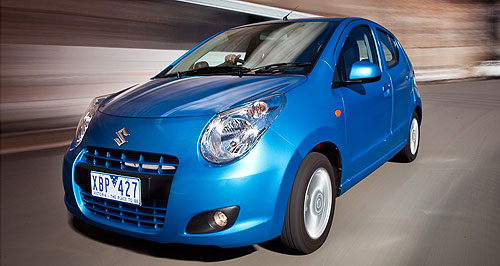Make / Model Search
News - General News - SalesCosts jump in RACV car ownership surveyCheap as chips: Suzuki’s Alto (GLX pictured) has replaced the Mitsubishi Mirage as the RACV’s cheapest car to run – although the cost of weekly ownership has gone up. Cheapest car costs slightly more a week to run this year, RACV finds23 Jun 2014 By BARRY PARK THE cost of running Australia’s cheapest car has jumped by almost $3 a week – about the price of a cup of coffee – the latest RACV survey of the weekly spend on keeping a vehicle in the driveway shows. The Driving Your Dollars survey, released last week, shows the cost of owning a five-speed manual Suzuki Alto GL city-sized hatch has risen from $114.27 a week in 2013 to $115.58 a week this year – an average of about 40.1 cents a kilometre – in line with a slight rise of the average cost of keeping a car to $212.01 – or an average of 73.5 cents a kilometre. The Alto has replaced the winner in last year’s survey, the Mitsubishi Mirage ES, rated at $112.81 a week, or 39.11 cents a kilometre in 2013. It now ranks third in its class this year with a cost of $120.08 a week, or 41.63 cents a kilometre. At the other end of the scale, Nissan’s 5.6-litre V8-engined Patrol ST-L off-roader keeps its title as the most expensive car to keep in the driveway, costing an average of $408.02 a week – or about $1.42 a kilometre and well up on the $397.84 a week it cost in last year’s survey. Part of the reason for the increase in running costs for the Alto was the rising price of fuel, the RACV said. “Interest rates have gone down since last year representing a saving for car owners but the cost of fuel has gone up, with LPG in particular being the worst hit,” RACV vehicle engineering manager Michael Case said. “On top of this the federal government rebate for buying or converting an LPG car finishes at the end of June. “This means some petrol vehicles are now cheaper to own and operate than their respective LPG versions,” he said. The end of the $1000 subsidy for vehicles converted in the factory means that the 3.0-litre V6-engined petrol version of the Commodore has an estimated weekly running cost of $228.05 – the cheapest in the large car segment – while the dual-fuel LPG version will cost $232.40 a week. Over at Ford, the version of the Falcon large family sedan powered by a turbocharged 2.0-litre four-cylinder engine is slightly cheaper than the dedicated LPG version to run, costing $240.24 a week compared with the 4.0-litre LPG-engined Falcon’s $244.01. The petrol-powered version of the Falcon using the 4.0-litre in-line six costs $250.22 a week, the survey shows. Aside from the Alto, the top five for low running costs, amounting to no more than 44.3 cents a kilometre, included the five-speed manual 1.2-litre Holden Barina Spark CD, five-speed manual 1.2-litre Mitsubishi Mirage ES, five-speed manual 1.2-litre Fiat 500 Pop, and the five-speed manual 1.4-litre Suzuki Swift GL. At the other end of the scale, the running cost heavyweights joining the Patrol include one of Mercedes-Benz’s current most popular models, the C200 sedan powered by a turbocharged 1.8-litre four-cylinder engine paired with a seven-speed automatic gearbox ($1.12 a kilometre), Toyota’s LandCruiser Prado GXL off-roader powered by a 4.0-litre petrol engine paired with a five-speed automatic ($1.15), and petrol and diesel versions of the Toyota LandCruiser fitted with six-speed automatics ($1.35 and $1.36 respectively). The skinflint cars in other categories included the Suzuki Swift GL hatchback fitted with a 1.4-litre four-cylinder engine and a five-speed manual gearbox (light, $115.58 a week), Holden Cruze Equipe hatchback using a 1.8-litre four-cylinder engine mated to a six-speed automatic (small, $156.02 a week) Volkswagen Jetta 118 TSI sedan using a turbocharged and supercharged 1.4-litre four-cylinder engine matched with a seven-speed dual-clutch gearbox (medium, $184.17), and Honda’s new Odyssey featuring a 2.4-litre petrol engine fitted with a continuously variable transmission ($217.42 a week). In the fast-growing SUV segment, the cheapest running costs are pinned to the front-wheel-drive Ford EcoSport Ambiente using a 1.5-litre engine with a six-speed automatic (small, $164.56), Holden Captiva 5 LT using a 2.2-litre turbo-diesel engine with a six-speed automatic (medium, $205.99), and the Holden Captiva 7 using the same driveline as the five-seat version (large, $219.20). Ford’s Falcon ute converted to run on LPG is the cheapest tradie at $198.26 a week, while the Toyota HiLux SR comes in as the cheapest dual-cab ute at $253.33 a week. All three electric vehicles surveyed cost more than the weekly average to own, the survey shows. Mitsubishi’s high-riding Outlander PHEV, featuring a petrol engine paired with a wall-rechargeable battery system and electric motors, is the cheapest plug-in vehicle to own, costing $245.21 a week. The all-electric Nissan Leaf hatchback costs $255.28 a week to run, while the other plug-in surveyed, Holden’s petrol-electric Volt that only costs the equivalent of a cup of coffee to recharge according to GM's local subsidiary, costs owners $279.81 a week. Conspicuous in their absence from the top three vehicles in each category of this year’s list are more mainstream hybrid vehicles. Honda’s Jazz soft hybrid hatchback sits at the lower end of the light car class with weekly costs of $158.18, while the locally made, mid-size Toyota Camry Hybrid sedan – the only other electrically assisted car to feature – costs $209.10 a week, and was fourth in its segment, the survey said.  Read more |
Click to shareGeneral News articlesResearch General News Motor industry news |












Facebook Twitter Instagram